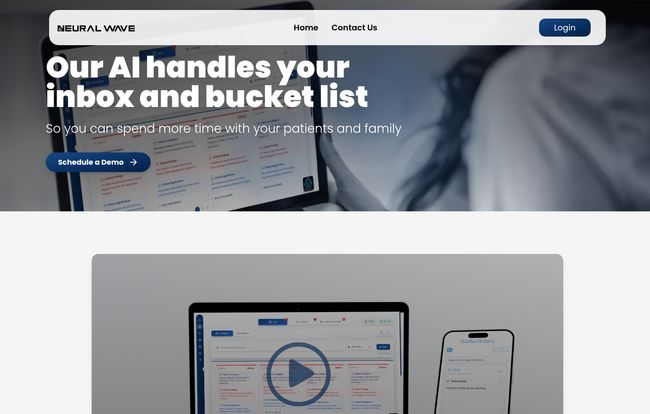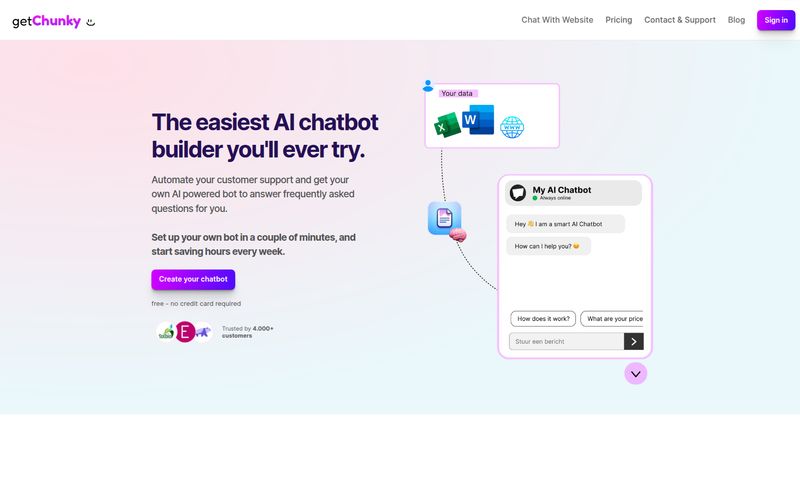If you're in healthcare, you're probably drowning. Not in medical emergencies, but in paperwork. Faxes from the 90s, lab results piling up, endless clinical notes... it’s a full-blown administrative pandemic. For every hour you spend with a patient, it feels like two are spent clicking boxes in an EHR or deciphering a fax that looks like a Rorschach test. It’s the number one complaint I hear from my friends in medicine, and it's the driving force behind the staggering rates of burnout we're seeing.
So when a tool comes along that calls itself a "smart co-worker" designed to handle the grunt work, my ears perk up. I’m talking about Neural Wave. It's not just another piece of software; the whole idea is to give healthcare providers an AI-powered assistant that automates those non-billable, soul-crushing tasks. The big promise? To give you back your time, and maybe even your sanity. But does it deliver?

Visit Neural Wave
So, What Is Neural Wave, Really?
Think of Neural Wave less as an app and more as a new team member. A very, very smart one that’s powered by Deep Learning and Generative AI. You know, the same kind of tech that’s wowing everyone right now. It understands natural language, so you don't have to learn a bunch of weird commands. You just tell it what to do, and it gets to work within the software you already use.
The core mission is simple: intercept the flood of information coming into your practice, make sense of it, and present it to you in a way that’s actually useful. It’s like having a hyper-efficient medical intern who never sleeps, never complains, and can read a thousand pages in the time it takes you to find your coffee. This isn’t about replacing people; it’s about augmenting them. It handles the tedious stuff so your team can focus on the human stuff—namely, patient care.
Winning the War Against Endless Paperwork
I was looking at their site and the client testimonial from Lawrenceville Family Practice really stood out. They said Neural Wave "saved us countless hours of paperwork and has lifted a significant burden off our providers." That's a bold claim, so let's break down how it supposedly pulls this off.
Taming the Fax Machine and Lab Reports
Ah, the medical fax. A true relic. Neural Wave steps in as a modern translator for these ancient scrolls. Its intelligent analysis feature can read faxes, pull out the important data, and even flag things like abnormal lab values or critical results. No more squinting at a blurry page trying to figure out if that's a 3 or an 8.
The same goes for lab results. Instead of just getting a data dump, the platform organizes it, highlights trends over time, and points out what needs your attention. The whole point is to reduce the chance of something getting missed in the daily deluge. It’s a safety net that also saves a ton of time. This means faster diagnoses and quicker follow-ups. And probably a lot more thank yous from patients.
Making Sense of Clinical Notes and Imaging
Discharge summaries, consult notes, progress reports... it’s a mountain of text. Neural Wave’s AI reads through these clinical documents to extract key information—problem lists, medications, recent orders, and follow-up needs. This gives you a much clearer picture of the patient's story without having to manually dig for it. For anyone dealing with value-based care, you’ll be happy to hear it also helps with improved and added HCC codes, which is a huge deal for proper billing and risk adjustment.
It does something similar for imaging reports. Whether it's an X-ray, CT scan, or MRI, the AI pulls out the key findings and clinical impressions. This context can be added to the patient's chart with a single click. It's all about making data more accessible and actionable at the point of care.
More Than Just Documents: Dictation and Scribing
Okay, processing documents is great, but the daily grind of documentation is another beast entirely. Neural Wave also offers an AI-powered medical scribe and dictation service. I’ve seen so many physicians get bogged down by their EHR, spending more time looking at a screen than at their patient. The idea here is to bring the conversation back to the exam room.
With high-accuracy dictation, you can speak naturally, and the AI translates your words into structured clinical notes. This is a game-changer. It frees you from the keyboard and lets you focus on the human connection, which is probably why you got into medicine in the first place. This feature alone could be worth its weight in gold for many practices.
The Real-World Impact: Less Burnout, Better Care
When you add it all up—the automated faxes, the intelligent lab reports, the one-click summaries, the seamless dictation—you start to see the bigger picture. This is about systematically dismantling the administrative burden that leads to burnout. It's about clawing back those hours spent on non-billable work and redirecting them toward patients, family, or even just a moment to breathe.
And of course, when clinicians are less stressed and better informed, patient care improves. Fewer missed findings, faster diagnoses, more face-to-face time... these aren't just buzzwords. They're tangible outcomes that can change lives. I think the true value here isn’t just efficiency; it’s the restoration of focus to what actually matters.
Okay, So What's the Catch?
No tool is perfect, and I always get a little skeptical when something sounds too good. So let's talk about the potential downsides. First, this is AI. As powerful as it is, it needs oversight. You can't just set it and forget it, especially in medicine. The provider is still the ultimate authority, and the AI is a tool to assist, not replace, clinical judgment. Its effectiveness is also tied to the quality of the data it's trained on, a common factor for all AI systems.
There might also be a bit of a learning curve. Integrating any new system into a clinic’s workflow takes time and effort. While it’s designed to be intuitive, getting the whole team on board and comfortable will require some adjustment. It's an investment of time upfront for a long-term payoff.
What's the Price Tag on This AI Assistant?
This is the part where I usually show a neat pricing table. But with Neural Wave, you won’t find one on their site. Instead, you'll see a "Schedule a Demo" button. This is super common for specialized, enterprise-level tools, especially in healthcare.
Why? Because every practice is different. A small family clinic has different needs than a large multi-specialty group. Pricing is likely customized based on the size of your practice, the features you need, and the level of integration with your existing EHR. So, to get the numbers, you'll have to have a conversation with their team. Don't let it deter you; it often means you'll get a solution that actually fits your specific workflow rather than a one-size-fits-all package.
Frequently Asked Questions About Neural Wave
What exactly is Neural Wave?
Neural Wave is an AI-powered platform that acts as a "smart co-worker" for healthcare providers. It automates administrative tasks like processing lab results, analyzing clinical documents, and medical dictation to free up time for patient care.
Who is this platform designed for?
It's built for healthcare providers and clinical practices of all sizes, from small family practices like Lawrenceville Family Practice to larger medical groups, who are looking to improve efficiency and reduce the administrative burden on their staff.
How does Neural Wave actually improve patient care?
By automating administrative work, it gives doctors more time to spend with patients. It also reduces the risk of missed information from lab reports or clinical notes, leading to faster, more accurate diagnoses and better-coordinated care.
Is it difficult to integrate into my current workflow?
While any new tool has an adjustment period, Neural Wave is designed to work with your existing software and understands natural language to minimize the learning curve. The goal is to assist your workflow, not overhaul it.
Will this AI replace my medical assistants or office staff?
No, the intention is not to replace staff but to augment them. It handles the most repetitive, time-consuming tasks, allowing your human staff to focus on higher-value activities like patient communication, complex scheduling, and hands-on care.
How accurate is the medical dictation and data analysis?
The platform uses advanced deep learning models to achieve high accuracy. However, like any AI, its effectiveness is very high but not infallible. It's designed as a powerful assistant, and final clinical oversight by the healthcare provider is always recommended.
Final Thoughts: A Glimpse into the Future of the Clinic?
After looking at everything Neural Wave offers, I'm genuinely optimistic. The problem it's tackling—physician burnout from administrative overload—is one of the most pressing issues in modern healthcare. This isn't just another shiny tech toy; it’s a targeted solution to a very real, very human problem.
The combination of intelligent document processing with high-quality medical scribing and dictation is powerful. It represents a shift from reactive documentation to proactive assistance. If it delivers on even half of its promise, it could fundamentally change the day-to-day reality for thousands of doctors and their staff.
Is it the single cure for burnout? Probably not. Burnout is a complex issue. But is it a massive step in the right direction? Absolutely. By giving doctors back their time, Neural Wave might just be giving them back a piece of the passion that led them to medicine in the first place.



